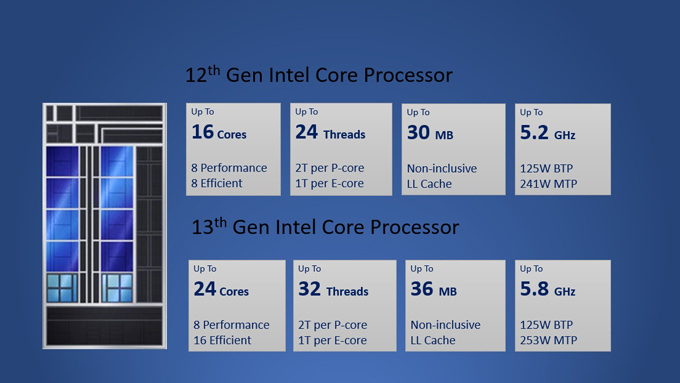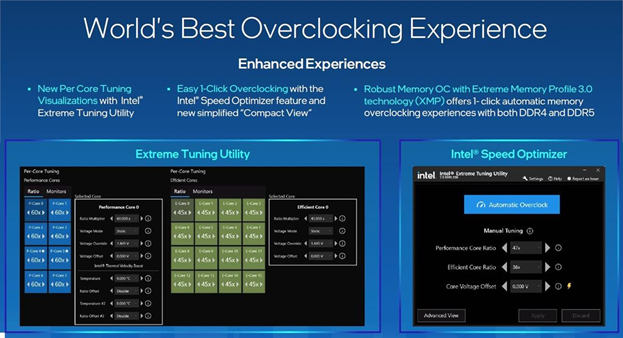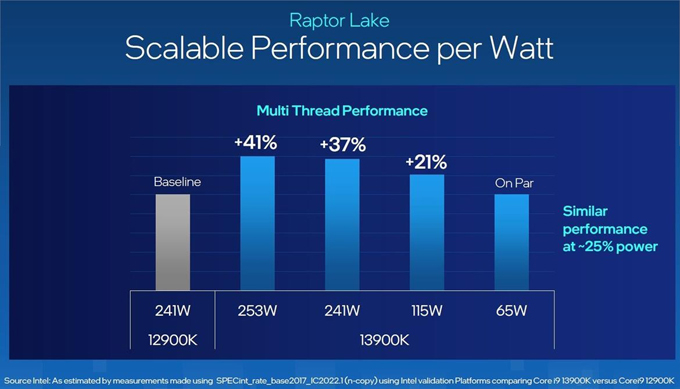
The 13th Gen Intel® Core™ Processor is the second family of CPU that utilizes Intel’s Hybrid architecture design incorporating both high performance P-Cores and highly efficient E-Cores. Additionally, it is the second product family built on the Intel 7 manufacturing node incorporating faster third-gen SuperFin transistors.
Following many industry firsts found on the Intel 12th Gen Intel® Core™ Processor such as PCIe Gen 5.0 and DDR5, the 13th Gen Intel Core Processor has many new technical advancements including up to 8 additional E-Cores, increased L2 as well as L3 cache, higher GHz, and advanced overclocking.
The combination of all these enhancements included in the 13th Gen Intel® Core™ Processor delivers a 15% gain in single threaded application performance as well as a 41% gain in multi-threaded performance compared to the 12th Gen Intel® Core™ Processor.
13th Gen Intel® Core™ Processor
- Hybrid Architecture utilizing both Performance Cores and Efficiency Cores
- Up to 24 Total Cores with up to 8 Additional Efficiency Cores Boosting performance in Multi-threaded workloads
- Up to 5.8GHx Max Turbo Mode for Performance cores increasing performance for single threaded applications such as gaming
- Up to 4.3GHz Max Turbo Mode for Efficient cores helping increase performance for multi-threaded or background applications
- Up to 32 Threads: 16 on Performance Cores / 16 on Efficient Cores
- 2.3X increase in L2 cache increasing up to 32MB
- 20% increase in L3 cache for up to 36MB
- Support for DDR5-5600 memory up from DDR5-4800.
- Continued support for DDR4-3200 memory based on the motherboard design
- Enhanced Over-Clocking including Per Core Tuning and Efficient Thermal Velocity Boost
- 16 PCIe 5.0 and 4 PCIe 4.0 for a total of 20 Processor Direct PCIe lanes
- LGA1700 Socket (Socket V)
- Compatible with both Intel 600 Series and Intel 700 Series Chipset Motherboards
- Intel Killer Wi-Fi6E

| Intel Processor | Cores (P+E) | Threads | P-Core Base/Boost | E Core Base/Boost | Cache (L2/L3) | Memory | Watt BTP / MTP |
|---|---|---|---|---|---|---|---|
| Core i9-13900K/KF | 24(8P+16E) | 32 | 3.0/5.8 | 2.2/4.3 | 64MB(32+36) | DDR4-3200/DDR5-5600 | 125W/253W |
| Core i9-12900K/KF | 16(8P+8E) | 24 | 3.2/5.2 | 2.4/3.9 | 44MB(14+30) | DDR4-3200/DDR5-4800 | 125W/241W |
| Core i7-13700K/KF | 16(8P+8E) | 24 | 3.4/5.4 | 2.5/4.2 | 54MB(24+30) | DDR4-3200/DDR5-5600 | 125W/253W |
| Core i7-12700K/KF | 12(8P+4E) | 20 | 3.6/5.0 | 2.7/3.8 | 37MB(12+25) | DDR4-3200/DDR5-4800 | 125W/190W |
| Core i5-13600K/KF | 14(6P+8E) | 20 | 3.5/5.1 | 2.6/3.9 | 44MB(20+24) | DDR4-3200/DDR5-5600 | 125W/181W |
| Core i5-12600K/KF | 10(6P+4E) | 16 | 3.7/4.9 | 2.8/3.6 | 29.5MB(9.5+20) | DDR4-3200/DDR5-4800 | 125W/150W |
Intel 700 Series Chipset and LGA1700 Socket
The 13th Gen Intel® Core™ Processor uses the same LGA1700 socket as the 12th Gen Intel® Core™ Processor, making it compatible with both the Intel 600 series chipset and the newer generation of Intel 700 series chipset motherboards. The Intel 700 series chipset includes all of the connectivity features found on the Intel 600 Series chipset such as Intel Killer Wi-Fi6E and Thunderbolt 4, but also provides additional PCI 4.0 chipset lanes, as well as additional high-speed USB 3.2 ports for greater I/O expansion compared to motherboards based on the Intel 600 series chipset.
Improved Cache
With the introduction of Intel’s Hybrid Architecture on the 12th Gen Intel® Core™ Processor also came a technically advanced cache structure that included up to 30MB of L3 cache that is shared, as well as 1.25MB of L2 Cache per P-Core and 2MB of L2 Cache per E-Core. With the 13th Gen Intel® Core™ Processor the L3 Cache is increased by up to 6MB for a maximum of 36MB. The L2 cache is also increased to 2MB per P-Core and 4MB per E-Core. The additional cache helps keep all the cores fed with data and reduces traffic helping to improve performance and increase IPC.
Additional cache is not the only change to the overall LLC structure. Intel uses advanced machine learning to allow the 13th Gen Intel® Core™ Processor to dynamically adjust its caching process to optimize performance in single threaded or multi-threaded applications. Changes include a new dynamic inclusive/non-inclusive caching algorithm or INI. Inclusive caching keeps all the multi-level, L1/L2 cache data in the LLC to dramatically improve hit rates and optimize single threaded performance. Non-Inclusive caching focuses on only copying select MLC data freeing up capacity in the LL3 which can improve multi-threaded performance.
DDR5 or DDR4 Memory
The 13th Generation Intel® Core™ Processor supports either DDR5-5600 or DDR4-4800 memory depending on the motherboard manufacturers design implementation. With a different pinout, DDR5 offers several key advantages over DDR4, which include 50% higher bandwidth going from 4.8Gbps to 6.4Gbps resulting in performance gains up to 87%. In addition, DDR5 draws slightly less power and supports higher density DIMMs which will reach 128GB per module. Currently DDR5 modules are available in 8, 16 and 32GB allowing for up to 512GB of memory on a standard board. DDR5 also includes on-die ECC designed in to support the larger capacity DIMMS. In addition, the Power Management IC is integrated in to the DDR5 module moving that function off the motherboard and creating more efficient and consistent voltage regulation.
PCI Gen 5.0
The 12th and 13th Generation Intel® Core™ Processor also supports an industry first PCIe Gen 5.0. Both generation of processor support 20 processor direct PCIe lanes which include 16 PCIe 5.0 and 4 PCIe 4.0 lanes. PCIe performance is measured in three ways which include giga transfers, bandwidth, and frequency each of which double from one generation of PCI to the next. This means PCIe Gen 5.0 has a giga transfer rate of 32GT/s, bandwidth of 128GB/s and a frequency of 32GHz all of which are double that of PCIe Gen 4.0 As with all generations of PCIe, the slots are backward as well as forward compatible.
Overclocking
The 12th Gen Intel® Core™ Processor introduced many new capabilities and overclocking features which have been enhanced for the 13th Gen Intel® Core™ Processor. The new 13th Generation model includes new per core tuning virtualizations using Intel Extreme Tuning Utility and has a simplified Intel Speed Optimizer. Additionally the 13th Gen Intel® Core™ Processor includes memory overclocking capability for both DDR4 and DDR5 memory which can be done with 1 click.

Scalable Performance Per Watt
With enhancements made with Intel 7 manufacturing node, the 13th Gen Intel® Core™ Processor has dramatically improved efficiency per watt allowing it to achieve the same performance as the 12th Gen Intel® Core™ Processor but at 25% less power. Conversely, at similar peak power, the 13th Gen Intel® Core™ Processor performance is improved by more than 41%.

For more information on the 12th and 13th Gen Intel® Core™ Processor please visit https://www.asipartner.com/solutions/gaming/12th-gen-intel-core-processors/
For configuration information for 12th and 13th Gen Intel® Core™ Processor please visit https://www.asipartner.com/intel-12th-gen-features/
